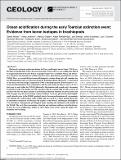Files in this item
Ocean acidification during the early Toarcian extinction event : evidence from boron isotopes in brachiopods
Item metadata
| dc.contributor.author | Müller, Tamás | |
| dc.contributor.author | Jurikova, Hana | |
| dc.contributor.author | Gutjahr, Marcus | |
| dc.contributor.author | Tomašových, Adam | |
| dc.contributor.author | Schlögl, Jan | |
| dc.contributor.author | Liebetrau, Volker | |
| dc.contributor.author | Duarte, Luís | |
| dc.contributor.author | Milovský, Rastislav | |
| dc.contributor.author | Suan, Guillaume | |
| dc.contributor.author | Mattioli, Emanuela | |
| dc.contributor.author | Pittet, Bernard | |
| dc.contributor.author | Eisenhauer, Anton | |
| dc.date.accessioned | 2020-09-09T14:30:04Z | |
| dc.date.available | 2020-09-09T14:30:04Z | |
| dc.date.issued | 2020-08-13 | |
| dc.identifier | 269947143 | |
| dc.identifier | e38b215e-a4c4-49f0-ae99-8b10ef5732de | |
| dc.identifier | 85092710365 | |
| dc.identifier.citation | Müller , T , Jurikova , H , Gutjahr , M , Tomašových , A , Schlögl , J , Liebetrau , V , Duarte , L , Milovský , R , Suan , G , Mattioli , E , Pittet , B & Eisenhauer , A 2020 , ' Ocean acidification during the early Toarcian extinction event : evidence from boron isotopes in brachiopods ' , Geology , vol. Early View . https://doi.org/10.1130/G47781.1 | en |
| dc.identifier.issn | 0091-7613 | |
| dc.identifier.uri | https://hdl.handle.net/10023/20595 | |
| dc.description | This project was funded by the European Union’s Horizon 2020 research and innovation program under the Marie Skłodowska-Curie grant agreement and project BASE-LiNE Earth (643084) and by the Slovak Research and Development Agency (APVV17-0555) and the Slovak Scientific Grant Agency (VEGA 0169/19). | en |
| dc.description.abstract | The loss of carbonate production during the Toarcian Oceanic Anoxic Event (T-OAE, ca.183 Ma) is hypothesized to have been at least partly triggered by ocean acidification linkedto magmatism from the Karoo-Ferrar large igneous province (southern Africa and Antarctica).However, the dynamics of acidification have never been directly quantified across theT-OAE. Here, we present the first record of temporal evolution of seawater pH spanning thelate Pliensbachian and early Toarcian from the Lusitanian Basin (Portugal) reconstructedon the basis of boron isotopic composition (δ11B) of brachiopod shells. δ11B declines by ~1‰across the Pliensbachian-Toarcian boundary (Pl-To) and attains the lowest values (~12.5‰)just prior to and within the T-OAE, followed by fluctuations and a moderately increasingtrend afterwards. The decline in δ11B coincides with decreasing bulk CaCO3 content, inparallel with the two-phase decline in carbonate production observed at global scales andwith changes in pCO2 derived from stomatal indices. Seawater pH had declined significantlyalready prior to the T-OAE, probably due to the repeated emissions of volcanogenicCO2. During the earliest phase of the T-OAE, pH increased for a short period, likely dueto intensified continental weathering and organic carbon burial, resulting in atmosphericCO2 drawdown. Subsequently, pH dropped again, reaching the minimum in the middle ofthe T-OAE. The early Toarcian marine extinction and carbonate collapse were thus driven,in part, by ocean acidification, similar to other Phanerozoic events caused by major CO2 emissions and warming. | |
| dc.format.extent | 5 | |
| dc.format.extent | 694579 | |
| dc.language.iso | eng | |
| dc.relation.ispartof | Geology | en |
| dc.subject | QE Geology | en |
| dc.subject | NDAS | en |
| dc.subject | SDG 14 - Life Below Water | en |
| dc.subject.lcc | QE | en |
| dc.title | Ocean acidification during the early Toarcian extinction event : evidence from boron isotopes in brachiopods | en |
| dc.type | Journal article | en |
| dc.contributor.institution | University of St Andrews. School of Earth & Environmental Sciences | en |
| dc.identifier.doi | https://doi.org/10.1130/G47781.1 | |
| dc.description.status | Peer reviewed | en |
This item appears in the following Collection(s)
Items in the St Andrews Research Repository are protected by copyright, with all rights reserved, unless otherwise indicated.

